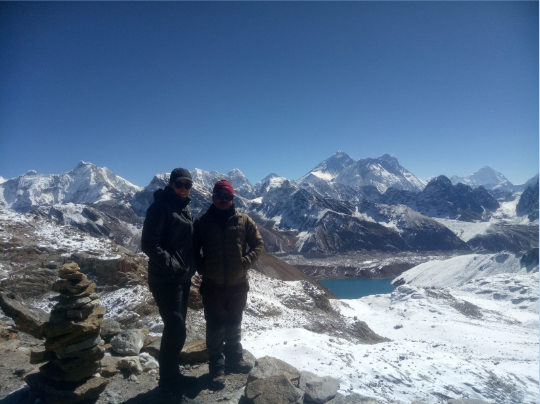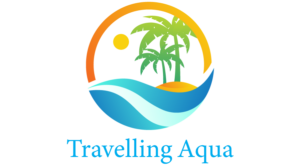At 6,189 meters (20,305 feet), Island Peak Climbing stands as one of Nepal’s most popular trekking peaks. The peak earned its name from its striking appearance as an island in a sea of ice when viewed from Dingboche. First climbed in 1953 by a British expedition team as part of Everest training, it now serves as an excellent introduction to Himalayan climbing.
The climb combines technical glacier travel with moderate rock climbing, requiring basic mountaineering skills. Climbers traverse the Khumbu region, passing through Sherpa villages and Buddhist monasteries while acclimatizing. The final ascent involves crossing crevassed glaciers and ascending a 45-degree snow and ice headwall using fixed ropes.
Key features:
- Duration: 15-20 days (including acclimatization)
- Best season: March-May, September-November
- Technical difficulty: PD+ (Peu Difficile Plus)
- Required skills: Basic ice axe and crampon use
- Stunning views of Lhotse, Makalu, and Ama Dablam
Lobuche Peak Climbing
Lobuche Peak Climbing (6,119m/20,075ft) offers a more technical climbing experience compared to Island Peak. Located in the Khumbu region, the peak presents two distinct summits: Lobuche East and Lobuche West. Most commercial expeditions target Lobuche East due to its accessibility and moderate technical challenges.
The route involves mixed climbing on rock, snow, and ice, with sections requiring careful rope work and protection placement. Climbers must navigate steep snow slopes up to 60 degrees and exposed ridge traverses. The summit provides unparalleled views of Everest, Lhotse, and the Khumbu Glacier.
Technical aspects:
- Duration: 16-21 days
- Best season: March-May, October-November
- Technical difficulty: TD (Tres Difficile)
- Required skills: Advanced crampon techniques, rope management
- Significant exposure and technical sections
Mera Peak Climbing
As Nepal’s highest trekking peak at 6,476 meters (21,247 feet),Mera Peak Climbing offers a less technical but physically demanding high-altitude experience. The peak consists of three main summits: Mera North, Mera Central, and Mera South. Most climbers target Mera Central, the highest point.
The approach through the remote Hinku Valley provides excellent acclimatization and showcases less-visited regions of the Khumbu. While technically straightforward, the altitude presents significant challenges. The final summit push involves climbing moderate snow slopes with breathtaking views of five 8,000-meter peaks.
Expedition highlights:
- Duration: 17-22 days
- Best season: March-May, September-November
- Technical difficulty: F+ (Facile Plus)
- Required skills: Basic snow climbing techniques
- Extensive glacier travel experience recommended
Everest Three Passes Trek
The Everest Three Passes Trek represents one of the most comprehensive and challenging trekking circuits in the Everest region. This non-technical but strenuous trek crosses three high passes: Kongma La (5,535m), Cho La (5,420m), and Renjo La (5,340m).

The trek provides a complete Khumbu experience, combining cultural insights with outstanding mountain vistas. Trekkers visit major landmarks including Everest Base Camp, Kala Patthar, and Gokyo Lakes while experiencing less-traveled routes between valleys.
Route characteristics:
- Duration: 18-22 days
- Best season: March-May, October-November
- Physical difficulty: Strenuous
- Maximum elevation: 5,535m at Kongma La
- Requires excellent physical conditioning
Conclusion
These Himalayan adventures represent different facets of high-altitude mountaineering and trekking. Island Peak and Lobuche serve as excellent introductions to technical climbing, while Mera Peak offers a high-altitude challenge with moderate technical demands. The Three Passes Trek provides a comprehensive trekking experience without technical climbing requirements.
Success on any of these routes demands proper acclimatization, physical preparation, and respect for the mountain environment. Each destination offers unique perspectives on the Himalayan landscape and Sherpa culture, making them valuable experiences for different skill levels and aspirations.
Key Takeaways
- Physical Preparation
- Minimum 6 months of targeted training required
- Focus on cardiovascular endurance and strength
- Previous high-altitude experience recommended
- Technical Requirements
- Island Peak: Basic mountaineering skills
- Lobuche: Intermediate technical climbing ability
- Mera Peak: Strong hiking background with basic snow skills
- Three Passes: Strong hiking experience only
- Seasonal Considerations
- Spring (March-May): Stable weather, warmer temperatures
- Autumn (September-November): Clear skies, colder conditions
- Avoid summer monsoon and winter seasons
Frequently Asked Questions
Q: Which peak is best for beginners? A: Mera Peak is technically easiest, though Island Peak offers a good introduction to technical climbing at altitude.
Q: Do I need previous climbing experience? A: For Lobuche Peak, yes. For others, basic mountaineering training during the expedition is usually sufficient.
Q: What is the success rate? A: Success rates vary: Three Passes (85%), Mera Peak (75%), Island Peak (70%), Lobuche Peak (65%).
Q: Can I combine multiple objectives? A: Yes, but allow sufficient time for acclimatization and recovery between climbs.
Q: What permits are required? A: All routes require TIMS cards and national park permits. Peaks need additional climbing permits.
| Comparison Table | Technical Difficulty | Duration (Days) | Max Elevation (m) | Best For |
| Island Peak | PD+ | 15-20 | 6,189 | Beginning climbers |
| Lobuche Peak | TD | 16-21 | 6,119 | Experienced climbers |
| Mera Peak | F+ | 17-22 | 6,476 | High-altitude trekkers |
| Three Passes | Non-technical | 18-22 | 5,535 | Experienced trekkers |
Contact Details;
Everest Trekking Routes Pvt. Ltd.
16 Khumbu, Nayabazaar, Kathmandu, Nepal
Mobile : +977-9843467921 (Rabin)
Email: info@everesttrekkingroutes.com
URL:- www.everesttrekkingroutes.com

